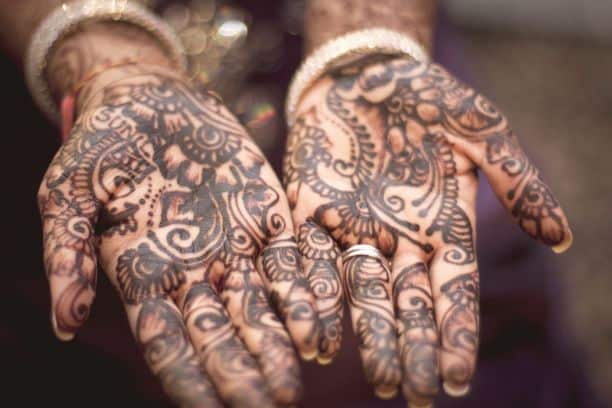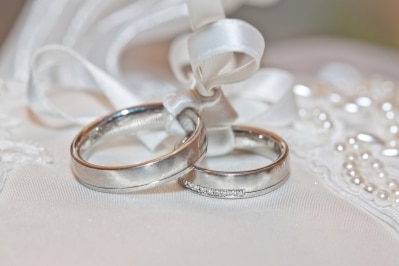Ultimate Guide: How Long Does Henna - Mehndi Tattoo Last?
Yes, mehndi and henna are two interchangeable words. The world mehndi comes from South Asia, and henna comes from Arabic. This post will cover everything from how long does Henna last to frequently asked questions.
Is Mehndi & Henna The Same Thing?

This Ultimate Guide to How Long Does Henna / Mehndi Last has all the information you need to learn about what henna is, how it’s made, and how you can use it for yourself.
Henna / Mehndi is a key part of the most intricate cultures of South Asia. The use of mehndi is a tradition that goes back hundreds and thousands of years. Mehndi comes from the henna plant. The leaves from the henna plant are collected and left in the sun to dry. Then they are crushed into a fine powder. Finally, the powder is mixed into a paste to apply to the skin and/or hair.
How Do You Make Organic Henna / Mehndi?
Ingredients
- Organic Henna Powder
- Organic Sugar
- Distilled or Purified Water
Tools Needed
- Bowl
- Silicone Spatula
- A Cup of water
Instructions
Mix the henna powder and sugar in a small bowl. Then slowly add water until it turns into a thick, batter-like paste. Lastly, let the mixture rest for 4 to 24 hours in the refrigerator. The next day, you can place the pasta in paper cones or use this applicator bottle from Amazon.
DIY Henna / Mehndi YouTube Video
If You Choose To Buy Henna / Mehndi, Then You Have 3 Options
- Prepared Henna Cone
- Organic Henna Power (to mix yourself)
- Gold/Silver Stickers
Five Simple & Easy Tips
- Tip One
Mehndi is a thick paste so use it like paint or color pencil. By adjusting the pressure, you can get different effects. Make sure to have plenty of paper towels handy for leakage.
- Tip Three
No matter the front or the back of the hand, be slow and steady when putting the mehndi on. Use a paper towel or paper to practice.
- Tip Two
Start at the center of the mehndi design or start at the wrist and work your way out to the fingertips. This technique will help keep the design centered.
- Tip Four
When applying mehndi, sometimes, you might get a little on your hands. Use gloves to help prevent stains from forming. If you get some on your hands, then wash as quickly as possible.
- Tip Five
Refrigerate the henna when you are not using it. This will help keep the mehndi fresh and long-lasting.
How Long Does Henna / Mehndi Tattoo Last On Your Skin?
After applying henna on your hands, leave it on as long as possible, up to 8 hours. This amount of time will ensure you have a good stain. If you must sleep with it on, consider wrapping it up or covering it with some bags so that it won’t stain your bed when the flakes drop off.
Henna Aftercare
Once the henna has completely dried and flaked off, then take a half of a lemon and rub it into the design as you are washing your hands of the rest of the henna reside. Rubbing in some oil afterward will deepen the color as well. We recommend Coconut oil or some skincare oil. Lastly, keep your hands as dry as possible so that the color lasts longer.
Henna is a temporary tattoo that could last for about two weeks. This depends on the number of times the area is washed with soap and water.
Significance Of Mehndi
The significance of having a henna function is to celebrate the event and wish well to one another. Henna is not a religious practice, but it is a tradition celebrated by billions of people by having henna ceremonies for many occasions.
For example, most South Asian weddings start with an event called mehndi night. This event usually takes place the night before the wedding day. Typically, the bride applies the mehndi on her hands and feet a few days before this event. This allows her to sit on a stage with the groom to watch family and friends sing and dance. There is usually a mehndi artist there so that the guests can get their hands done too.
What Should I Wear To A Mehndi Party?
The mehndi night party attire is usually bright colored clothes—for example, salwar kameez, lehengas, ghararas, Sari, or Desi gowns. Although one can wear any color, most of the time, lots of different shades of yellow are used. The bride’s outfit is usually bright, multi-color, or yellow traditional clothes.
Check out this post on different South Asian Fashions.
Henna / Mehndi Design
Bridal henna designs are very elaborate with complex detail. It is done on most of the hands, arms, and feet. For most other occasions, simple and easy designs too that can look just as elegant.

